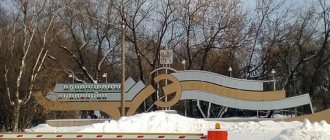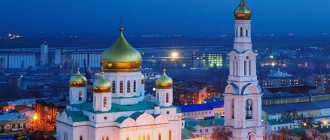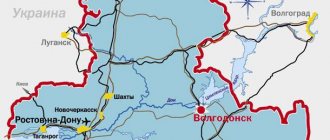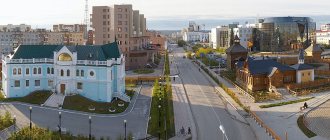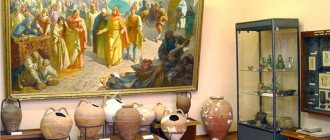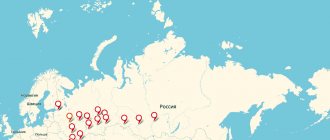Rostov-on-Don
Rostov-on-Don is the capital of the Don region and the Southern Federal District
Symbolism
| Flag | Coat of arms |
Administration
346007, Rostov-on-Don, Bolshaya Sadovaya st., 47
tel., fax
Housing and communal services hotline
Head of the city administration
Logvinenko Alexey Valentinovich
Chairman of the City Duma - mayor of the city
Zinaida Vasilievna Neyarokhina
Geography
Rostov-on-Don is the administrative center of the Rostov region and the Southern Federal District of Russia with a population of more than 1 million people.
The city is located in the southeast of the East European Plain, on the banks of the Don River, 46 km from its confluence with the Sea of Azov, in the center of transport routes providing access to three seas - the Black, Azov, Caspian - and direct contacts with the entire European part of the CIS, Transcaucasia, the Middle East and the Mediterranean. The area of the city is 348.5 sq. km, the distance to Moscow is 1076 km.
Story
The founding date of Rostov-on-Don is considered to be 1749, when the Russian Empress Elizaveta Petrovna signed a Decree establishing a state customs office at the mouth of the Temernik River. After this, a port appeared here, and in 1761 the construction of the military fortress of St. Demetrius of Rostov began. The favorable geographical position contributed to the economic development of Rostov. By its 100th anniversary, the city had about 15 thousand inhabitants, and by the 20th century over 110 thousand people lived in it. The basis of the economy of Rostov-on-Don was trade, and the city itself was called a merchant city. However, by the beginning of the 20th century, there were already more than 100 enterprises operating in it, every third of which belonged to foreign capital. Until 1917, Rostov-on-Don was the third city in Russia in terms of foreign trade turnover. By the end of the 30s, in terms of population and level of economic development, it was one of the ten largest cities in the Soviet Union.
Rostov-on-Don entered the heroic chronicle of the Great Patriotic War as a city where the Red Army went from defense to offensive. Rostov-on-Don was a strategic goal in the plans of the fascist command - it was not for nothing that Goebbels called it “the gates of the Caucasus.” But it was here, at the “gates of the Caucasus,” in November 1941 that the Wehrmacht suffered its first major defeat. During the occupation of the city, the Nazis shot and tortured tens of thousands of civilians, and drove about 50 thousand people into slavery. The central areas of the city were turned into ruins, the buildings of theaters, institutes, schools and hospitals were blown up and burned. Of the 270 factories and factories, only six survived. However, thanks to the dedicated work of Rostovites, the capital of the Don was restored from ruins and became even more beautiful.
In 1970, by Decree of the Supreme Soviet of the USSR, the city of Rostov-on-Don was awarded the Order of Lenin; in 1982, by Decree of the Presidium of the Supreme Soviet of the USSR, it was awarded the Order of the Patriotic War, 1st degree. On the eve of the celebration of the 63rd anniversary of Victory in the Great Patriotic War, Rostov-on-Don was awarded the honorary title “City of Military Glory”. Today Rostov-on-Don is one of the largest megacities of modern Russia, a political, economic, cultural and scientific center of the south of the country, an important junction of transport routes.
Economy
Positioning as the capital of southern Russia and the localization in the city of large industrial enterprises and structures of a southern Russian scale (management of SKZD, etc.) determines an additional concentration of jobs in Rostov-on-Don, provides an increased level of economic activity and investment attractiveness.
Rostov-on-Don is the eighth most populous city in the Russian Federation (excluding the cities of Moscow and St. Petersburg) and stands out noticeably among Russian cities with a population of over a million, ranking first in the number of individual entrepreneurs per thousand residents. The city is among the top five in terms of housing commissioning and budgetary provision per capita.
Based on the results of a competition held by the Club of Municipal Leaders (KRMS) in 2022, the city of Rostov-on-Don was awarded a badge of honor and a diploma in the category “100 Growing Municipal Economies of Russia.”
A factor favoring the socio-economic development of the city is its positioning as the “core” of the Rostov agglomeration with a demographic potential of up to 2.3 million people, forming the largest local consumer market in the south of Russia, which concentrates a significant part of the scientific, educational, industrial and financial -investment potential of the region.
In a popular vote among Russian cities with a developed IT infrastructure, a good base for training specialists, promising projects and startups, Rostov-on-Don received the title of IT capital of Russia.
Culture
There are 220 cultural and art institutions in Rostov, creative unions and national cultural societies.
At different times, such outstanding writers as A. Solzhenitsyn, M. Nalbandyan, M. Shaginyan, V. Panova, A. Fadeev, artists M. Grekov, M. Saryan and V. Shcheblanov, composers and musicians A. lived and worked in the city. Artamonov and K. Nazaretov, actors Y. Zavadsky and V. Maretskaya. Rostov-on-Don is the birthplace of the Russian ballerina O. Spesivtseva, the outstanding singer of the 20th century I. Yuryeva, and People's Artist of the USSR R. Plyatt.
Rostov-on-Don is a major educational and scientific center. There are 22 institutions of higher professional education here, with more than 130 thousand students.
In Rostov-on-Don there are 4 theaters, two of which are academic, 4 museums, the largest Don State Public Library in the south of the country, a state circus, a regional philharmonic society, the Rostov State Conservatory (Academy) named after. S.V. Rachmaninov, Rostov-on-Don branch of the St. Petersburg State University of Culture and Arts, college of arts, college of culture, exhibition halls of artists.
One of the largest zoos in Europe has been operating in Rostov-on-Don for 94 years. This corner of fauna, covering an area of 60 hectares, is inhabited by about 5 thousand individuals, including more than 500 species of rare animals, birds and reptiles, more than 180 of which are listed in the Red Book. The Botanical Garden is considered one of the largest gardens in Russia, with an area of 161 hectares.
Rostov-on-Don is also one of the largest jazz centers in the country. It is here, like nowhere else in the world, that the basis of pop-jazz education is strong, which was laid in the early 1980s by the country’s first “professor of jazz” Kim Nazaretov, who opened the department of pop-jazz music at the Rostov Conservatory. The city has a unique, the only children's jazz school named after K. Nazaretov in the country.
It has become a good tradition to hold in Rostov-on-Don the theater festivals “Minifest”, “Russian Comedy”, international jazz festivals, the International Festival “Accordion Plus”, the competition of children and youth pop performers “Stars of Rostov”, young composers and other competitions of all genres folk art.
In 2022, the First Merchant Festival named after. A.P. Chekhov “In the City Garden”, dedicated to the 272nd anniversary of the founding of the city of Rostov-on-Don.
Attractions
Sights of Rostov-on-Don
Working area
The working area of Rostov-on-Don is located in the Zheleznodorozhny district of the city. Surrounded mainly by old residential buildings, it is a recreation area, or rather a small square, where local residents come. There is a circular movement of cars around the square, and the square itself, like an island of safety and peace, invites you to take a walk. There are children's playgrounds, pavilions selling drinks and ice cream, and fountains. The area is old, inhabited, and therefore very green and cozy. In the surrounding houses there are numerous shops and services that ensure the normal functioning of people.
What to see in the area
The wooden church in the village of Bogoslov, located 3 kilometers from the city center, is the only one preserved in the Yaroslavl region. The 17th century is a celebrity of its own: the famous artist Vasily Vereshchagin painted a couple of paintings inside. It seems that Emperor Nicholas II visited the village and church while passing through.
The Church of St. John the Evangelist today is a branch of the Yaroslavl Museum-Reserve and is open to visitors only from May to October. Monday-Tuesday is traditionally a weekend.
Note that just 58 km northeast on the banks of the Volga lies another magnificent Golden Ring city, Yaroslavl. Approximately 130 km along the highway to Kostroma - that's less than 3 hours' drive if by car!
Textile ]Ivanovo[/anchor] is also located at approximately the same distance! “City of Brides” and two wonderful museums: chintz and local history. The first is located in the mansion of local industrialist and philanthropist D.G. Burylin, and the second - in a building specially built by him. Visitors are offered a rich collection of various items.
© Eurotraveler.ru
Where to stay
You can spend the night in Rostov the Great not only in an ordinary hotel or apartment - the Trinity-Sergius Varnitsky Monastery will also gladly accommodate city guests. However, don’t count on private rooms. And you will have to get to the city center!
But staying at the guest house “On Valakh”, you can walk to the entrance to the local Kremlin in 3-4 minutes. The house is decorated in traditional Russian style and is very well maintained. The rooms have a standard set of amenities and even more: a refrigerator and microwave.
In a beautiful location right on the shore of Lake Nero there is a brand new hotel with the not-so-Russian name Bravis Holiday Park. But those who stayed praise the cleanliness of the rooms and the views from the windows. And the presence of a good restaurant is an important bonus for a traveler who is tired from the road.
Gender and age
To obtain an accurate demographic picture, it is necessary to analyze the gender and age composition. According to official data provided by Rostovstat, the proportion of male citizens is 46.4%. The share of women is, respectively, 53.6%. The number of men, according to official statistics, is gradually increasing.
Today in the Rostov region, per 1000 citizens of working age there are 806 residents whose age is above/below the working age. The share of children and adolescents is 17%. Representatives of the older age group – 26.7% of city residents.
Data for the Rostov region

